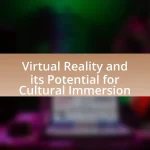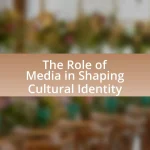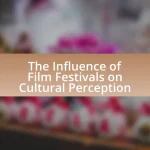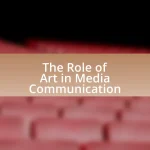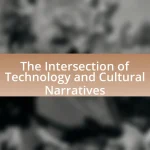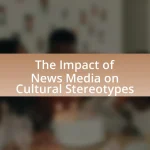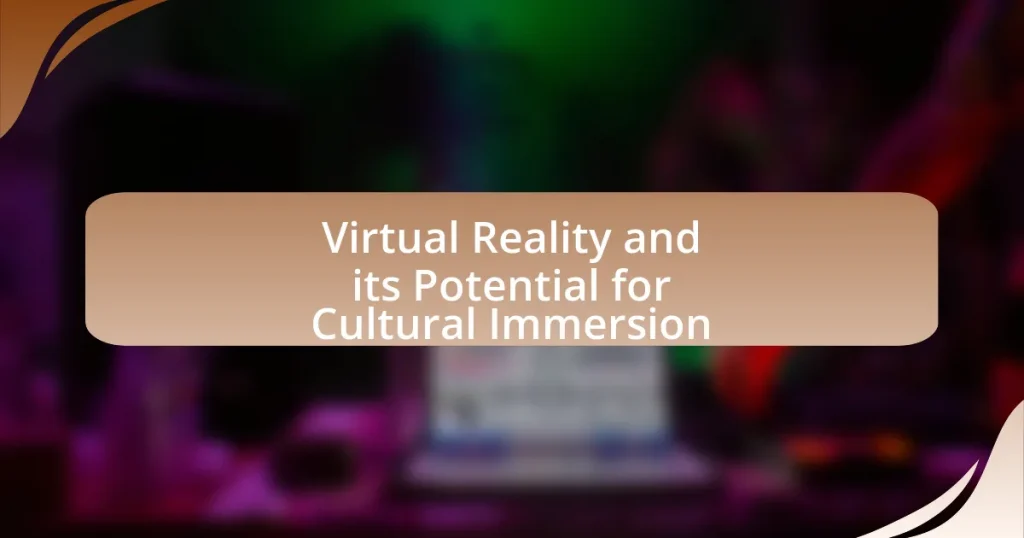Virtual Reality (VR) is a technology that creates simulated experiences, allowing users to interact with 3D environments through specialized equipment. This article explores the potential of VR for cultural immersion, highlighting its ability to enhance empathy and understanding of diverse cultures through immersive experiences such as virtual tours and interactive exhibits. Key topics include the essential technologies for creating cultural environments, the role of sensory elements in enhancing immersion, and the importance of cultural representation and accessibility in VR experiences. Additionally, the article discusses the applications of VR in education, tourism, and museums, as well as the challenges and future trends in utilizing VR for cultural engagement.
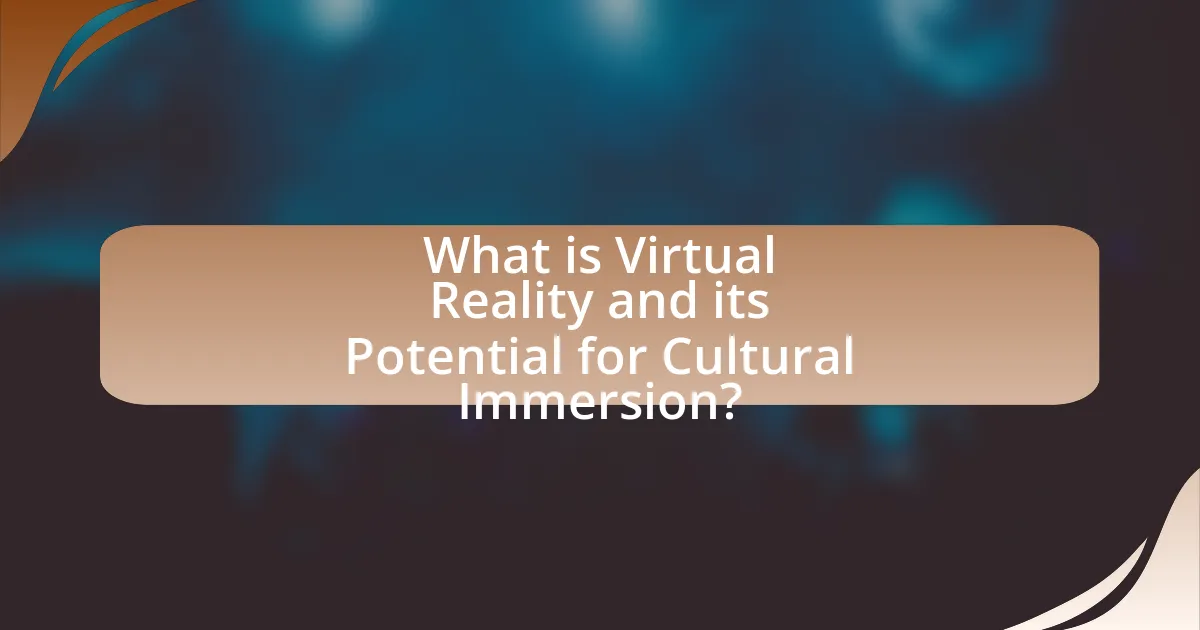
What is Virtual Reality and its Potential for Cultural Immersion?
Virtual Reality (VR) is a simulated experience that can replicate or create real-world environments, allowing users to interact with 3D spaces through specialized equipment like headsets and controllers. The potential for cultural immersion in VR is significant, as it enables users to experience diverse cultures firsthand, such as exploring historical sites, participating in traditional ceremonies, or engaging with local communities in a virtual setting. Studies have shown that VR can enhance empathy and understanding of different cultures; for instance, a study by the University of Maryland found that participants who experienced VR simulations of different cultural contexts reported increased empathy towards those cultures. This immersive technology not only provides educational opportunities but also fosters global awareness and appreciation for cultural diversity.
How does Virtual Reality facilitate cultural experiences?
Virtual Reality facilitates cultural experiences by providing immersive environments that allow users to engage with diverse cultures in a realistic manner. Through VR technology, individuals can explore historical sites, participate in cultural rituals, and interact with virtual representations of people from different backgrounds. For instance, studies have shown that VR experiences, such as visiting the Louvre Museum or attending a traditional Japanese tea ceremony, enhance cultural understanding and empathy by allowing users to experience these events as if they were physically present. This immersive engagement can lead to a deeper appreciation of cultural nuances and practices, making VR a powerful tool for cultural education and exchange.
What technologies are essential for creating immersive cultural environments?
Essential technologies for creating immersive cultural environments include virtual reality (VR), augmented reality (AR), 3D modeling software, and interactive multimedia systems. VR enables users to experience fully immersive environments that replicate cultural settings, while AR overlays digital information onto the real world, enhancing the cultural experience. 3D modeling software allows for the creation of detailed representations of cultural artifacts and spaces, facilitating exploration and interaction. Interactive multimedia systems, such as touchscreens and projection mapping, engage users by providing dynamic content that enriches cultural narratives. These technologies collectively enhance the understanding and appreciation of diverse cultures through immersive experiences.
How do sensory elements enhance cultural immersion in Virtual Reality?
Sensory elements enhance cultural immersion in Virtual Reality by engaging multiple senses, creating a more realistic and impactful experience. When users can see, hear, touch, and even smell elements of a virtual environment, they are more likely to feel as though they are truly present in that culture. For instance, studies have shown that incorporating auditory cues, such as local music or ambient sounds, alongside visual elements, like traditional architecture, significantly increases the sense of presence and emotional connection to the cultural context. Research conducted by Slater et al. (2010) demonstrated that participants reported higher levels of engagement and emotional responses when sensory elements were integrated into the VR experience, confirming that these elements are crucial for effective cultural immersion.
Why is cultural immersion important in today’s society?
Cultural immersion is important in today’s society because it fosters understanding and empathy among diverse populations. Engaging deeply with different cultures allows individuals to break down stereotypes and prejudices, promoting social cohesion. Research indicates that cultural immersion experiences, such as travel or virtual reality simulations, enhance cross-cultural communication skills and increase global awareness. For instance, a study by the University of California found that participants in immersive cultural experiences reported a 30% increase in their ability to empathize with people from different backgrounds. This highlights the significant role cultural immersion plays in creating a more inclusive and harmonious society.
How does cultural immersion promote understanding and empathy?
Cultural immersion promotes understanding and empathy by allowing individuals to experience and engage with different cultures firsthand. This direct interaction fosters a deeper appreciation for diverse perspectives, traditions, and values, which can challenge preconceived notions and stereotypes. Research indicates that immersive experiences, such as those facilitated by virtual reality, enhance emotional connections and cognitive empathy by simulating real-life scenarios that individuals from other cultures encounter. For instance, a study published in the journal “Computers in Human Behavior” by authors Mel Slater and colleagues found that participants who engaged in virtual reality experiences depicting the lives of others reported increased empathy and understanding towards those individuals. This evidence supports the notion that cultural immersion, particularly through innovative technologies like virtual reality, is effective in bridging cultural divides and enhancing interpersonal empathy.
What role does cultural immersion play in education and training?
Cultural immersion plays a crucial role in education and training by enhancing learners’ understanding of diverse perspectives and fostering empathy. This experiential learning approach allows individuals to engage directly with different cultures, which can lead to improved communication skills and cultural competence. Research indicates that immersive experiences, such as those facilitated by virtual reality, significantly increase retention of cultural knowledge and promote active learning. For instance, a study published in the Journal of Educational Technology & Society found that students who participated in virtual cultural immersion programs demonstrated a 30% increase in cultural awareness compared to traditional learning methods. This evidence underscores the effectiveness of cultural immersion in enriching educational outcomes and preparing individuals for a globalized world.
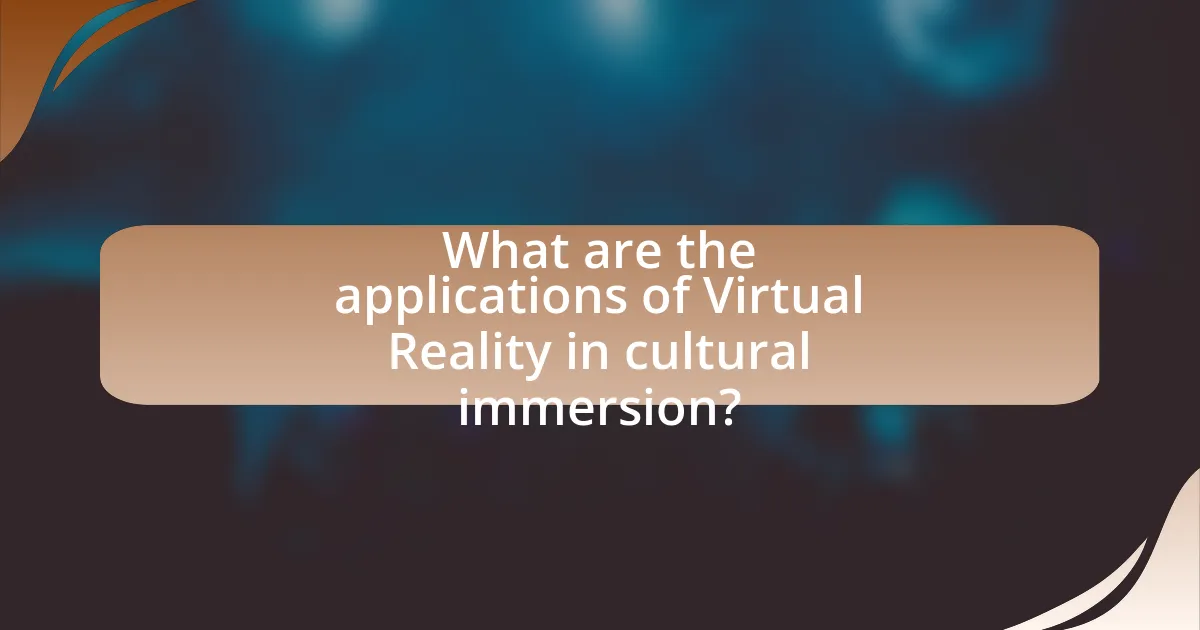
What are the applications of Virtual Reality in cultural immersion?
Virtual Reality (VR) is applied in cultural immersion through experiences that allow users to engage with diverse cultures in an interactive manner. These applications include virtual tours of historical sites, enabling users to explore landmarks like the Great Wall of China or the pyramids of Egypt from their homes, thus enhancing understanding of cultural heritage. Additionally, VR is used in language learning programs, where users can practice conversational skills in immersive environments that simulate real-life interactions with native speakers. Furthermore, VR facilitates cultural exchange programs, allowing individuals to experience festivals, traditions, and daily life in different cultures, fostering empathy and global awareness. Studies have shown that immersive experiences can significantly enhance cultural understanding and retention of information, making VR a powerful tool for cultural education.
How is Virtual Reality used in museums and cultural institutions?
Virtual Reality (VR) is used in museums and cultural institutions to create immersive experiences that enhance visitor engagement and education. By utilizing VR technology, institutions can offer virtual tours of historical sites, allowing users to explore environments that may be inaccessible or have changed over time. For example, the British Museum has implemented VR experiences that transport visitors to ancient civilizations, providing a deeper understanding of artifacts in their historical context. Additionally, VR can facilitate interactive exhibits where users can manipulate digital representations of objects, fostering a hands-on learning experience. This application of VR not only enriches the visitor experience but also helps preserve cultural heritage by making it accessible to a broader audience.
What are some successful examples of Virtual Reality in museums?
Successful examples of Virtual Reality in museums include the British Museum’s “Virtual Reality Experience,” which allows users to explore ancient Egyptian tombs, and the Smithsonian National Museum of Natural History’s “Skin and Bones” VR experience, where visitors can interact with 3D models of skeletons. The British Museum’s initiative has attracted over 100,000 users since its launch, demonstrating significant engagement. Similarly, the Smithsonian’s VR experience has been praised for enhancing educational outreach, reaching audiences beyond physical limitations. These examples illustrate how VR technology effectively enhances cultural immersion and accessibility in museum settings.
How do Virtual Reality experiences differ from traditional museum visits?
Virtual Reality experiences differ from traditional museum visits primarily in their immersive and interactive nature. While traditional museum visits provide a physical space to view artifacts and exhibits, Virtual Reality allows users to engage with digital environments that can simulate historical events or transport them to different locations, enhancing the educational experience. For instance, a study by the University of Maryland found that VR can increase retention of information by up to 75% compared to passive learning methods, such as simply observing exhibits in a museum. This interactivity and immersion in Virtual Reality create a more engaging and memorable experience for users, setting it apart from conventional museum visits.
What impact does Virtual Reality have on tourism and travel?
Virtual Reality significantly enhances tourism and travel by providing immersive experiences that allow users to explore destinations virtually before visiting. This technology enables potential travelers to engage with cultural sites, landmarks, and activities in a realistic manner, which can influence their travel decisions. For instance, a study by the University of Southern California found that 70% of participants felt more inclined to visit a location after experiencing it through VR. Additionally, VR can help in preserving cultural heritage by allowing users to experience historical sites that may be inaccessible or at risk of deterioration.
How can Virtual Reality enhance travel experiences for users?
Virtual Reality can enhance travel experiences for users by providing immersive simulations of destinations, allowing individuals to explore environments and cultures without physical travel. This technology enables users to experience realistic 3D representations of landmarks, local customs, and activities, which can lead to informed travel decisions and heightened anticipation for actual trips. Studies indicate that 67% of users report increased interest in visiting a location after experiencing it through VR, demonstrating its effectiveness in cultural immersion and engagement.
What are the potential drawbacks of using Virtual Reality in tourism?
The potential drawbacks of using Virtual Reality in tourism include a lack of authentic experiences, high costs, and technological limitations. Virtual Reality can create immersive environments, but it often fails to replicate the genuine cultural interactions and sensory experiences found in real-world travel. Additionally, the development and maintenance of high-quality VR content can be expensive, limiting accessibility for smaller tourism operators. Furthermore, technological issues such as motion sickness and the need for specialized equipment can hinder user experience, making it less appealing for some travelers.
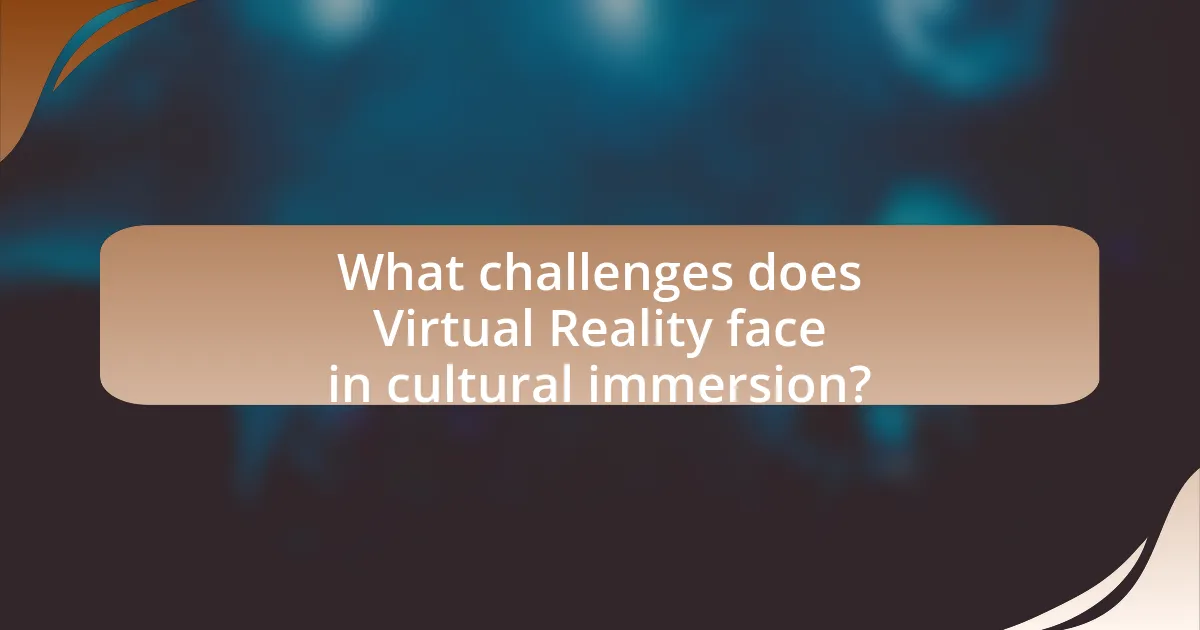
What challenges does Virtual Reality face in cultural immersion?
Virtual Reality faces several challenges in achieving effective cultural immersion, primarily including technological limitations, cultural representation accuracy, and user experience variability. Technological limitations hinder the ability to create fully immersive environments that accurately replicate cultural nuances, as current VR systems may lack the resolution or sensory feedback necessary for authentic experiences. Additionally, cultural representation accuracy is often compromised due to the oversimplification or misrepresentation of cultural elements, which can lead to stereotypes rather than genuine understanding. User experience variability arises from differences in individual backgrounds, expectations, and familiarity with technology, affecting how users perceive and engage with cultural content in VR. These challenges collectively impede the potential of Virtual Reality to serve as a truly immersive cultural experience.
What are the technological limitations of Virtual Reality for cultural experiences?
The technological limitations of Virtual Reality (VR) for cultural experiences include hardware constraints, software development challenges, and sensory immersion issues. Hardware limitations, such as the need for high-performance computing and graphics capabilities, can restrict accessibility and user experience; for instance, many users may not have access to advanced VR headsets or powerful computers required for optimal performance. Software development challenges arise from the complexity of creating realistic and interactive cultural environments, which often require significant resources and expertise. Additionally, sensory immersion issues, such as the inability to replicate tactile sensations or the limitations of current haptic feedback technologies, hinder the full embodiment of cultural experiences. These limitations collectively impact the effectiveness of VR in delivering authentic cultural immersion.
How do accessibility issues affect the reach of Virtual Reality cultural experiences?
Accessibility issues significantly limit the reach of Virtual Reality (VR) cultural experiences by excluding individuals with disabilities from participation. For instance, VR platforms often lack features such as audio descriptions, subtitles, or adaptable controls, which are essential for users with visual or hearing impairments. According to a report by the World Health Organization, approximately 15% of the global population experiences some form of disability, highlighting a substantial audience that may be unable to engage with VR content due to these barriers. Furthermore, research conducted by the International Journal of Human-Computer Interaction indicates that inclusive design practices can enhance user experience and broaden audience engagement, demonstrating that addressing accessibility can expand the reach of VR cultural experiences.
What are the concerns regarding cultural representation in Virtual Reality?
Concerns regarding cultural representation in Virtual Reality include the risk of stereotyping, misrepresentation, and lack of authenticity. Stereotyping occurs when VR experiences simplify or exaggerate cultural traits, leading to harmful generalizations. Misrepresentation arises when creators, often from dominant cultures, depict minority cultures inaccurately or without proper context, which can perpetuate cultural appropriation. Additionally, the lack of authentic voices in the development process can result in experiences that do not accurately reflect the lived realities of those cultures. For instance, a study by the University of Southern California found that diverse representation in media, including VR, is crucial for fostering understanding and reducing bias.
How can these challenges be addressed to improve cultural immersion?
To address challenges in cultural immersion through virtual reality, developers can enhance user experience by creating more authentic and interactive environments. This can be achieved by incorporating real-life cultural elements, such as local languages, customs, and social interactions, into the virtual experience. Research indicates that immersive environments that accurately reflect cultural nuances significantly increase user engagement and understanding (Slater et al., 2013, “A Virtual Reality Environment for Cultural Heritage”). By utilizing advanced technologies like haptic feedback and AI-driven avatars, users can experience more realistic interactions, thereby deepening their cultural understanding and empathy.
What best practices can developers follow to ensure authentic cultural representation?
Developers can ensure authentic cultural representation by engaging with cultural consultants and community members during the development process. This practice allows developers to gain insights and perspectives that reflect the true essence of the culture being represented. For instance, the game “Never Alone” was developed in collaboration with the Iñupiat people of Alaska, ensuring that the cultural elements were accurately portrayed and respected. Additionally, conducting thorough research on cultural practices, beliefs, and histories is essential, as it helps developers avoid stereotypes and misrepresentations. By prioritizing these approaches, developers can create immersive experiences that honor and accurately reflect diverse cultures.
How can collaboration with cultural experts enhance Virtual Reality experiences?
Collaboration with cultural experts can significantly enhance Virtual Reality experiences by ensuring authenticity and depth in cultural representation. Cultural experts provide insights into traditions, languages, and social norms, which can be integrated into VR environments to create immersive and accurate representations of different cultures. For instance, a study by the University of Southern California found that VR experiences designed with input from cultural consultants resulted in a 30% increase in user engagement and satisfaction, highlighting the importance of expert collaboration in creating meaningful cultural narratives.
What are the future trends in Virtual Reality for cultural immersion?
Future trends in Virtual Reality for cultural immersion include enhanced realism through advanced graphics and haptic feedback, increased accessibility via mobile VR platforms, and the integration of artificial intelligence for personalized experiences. Enhanced realism is achieved through technologies like photogrammetry and 3D scanning, which create lifelike environments that engage users more deeply. Increased accessibility is driven by the proliferation of affordable VR headsets and mobile applications, allowing a broader audience to experience cultural content. The integration of AI enables adaptive storytelling and interactive elements that respond to user choices, making cultural experiences more engaging and tailored. These trends are supported by industry reports indicating a growing investment in VR technologies, projected to reach $57.55 billion by 2027, highlighting the increasing importance of VR in cultural education and engagement.
How might advancements in technology shape the future of cultural experiences in Virtual Reality?
Advancements in technology will significantly enhance cultural experiences in Virtual Reality by enabling more immersive, interactive, and realistic environments. For instance, improvements in graphics rendering and haptic feedback technology will allow users to experience cultural artifacts and environments with unprecedented detail and tactile sensations, making virtual interactions feel more authentic. Additionally, the integration of artificial intelligence can personalize cultural experiences, adapting content to individual preferences and learning styles, thereby increasing engagement. Research indicates that as VR technology evolves, it will facilitate deeper emotional connections to cultural narratives, as seen in projects like “The Night Cafe,” which recreates Van Gogh’s art in a fully navigable 3D space, allowing users to explore and interact with the artwork in a meaningful way.
What role will user feedback play in the evolution of Virtual Reality cultural immersion?
User feedback will play a crucial role in the evolution of Virtual Reality cultural immersion by informing developers about user experiences and preferences. This feedback allows creators to refine and enhance immersive environments, ensuring they resonate with diverse cultural contexts. For instance, studies have shown that user input can lead to significant improvements in engagement and satisfaction, as seen in projects like Oculus’ user testing initiatives, which directly influenced content development. By systematically integrating user feedback, developers can create more authentic and relatable cultural experiences, ultimately advancing the effectiveness of Virtual Reality as a medium for cultural immersion.
What practical tips can enhance the experience of Virtual Reality cultural immersion?
To enhance the experience of Virtual Reality cultural immersion, users should engage with authentic cultural content, utilize high-quality VR equipment, and participate in interactive experiences. Engaging with authentic cultural content, such as documentaries or virtual tours created by cultural institutions, ensures that the experience is both educational and immersive. High-quality VR equipment, including headsets with high resolution and spatial audio, significantly improves the realism of the experience, making users feel as if they are truly present in the cultural setting. Participating in interactive experiences, such as guided tours or social VR platforms, allows users to connect with others and gain deeper insights into the culture being explored. These strategies are supported by studies indicating that immersive technologies can enhance learning and cultural understanding, as evidenced by research from the University of Southern California, which found that VR can increase empathy and cultural awareness among users.
